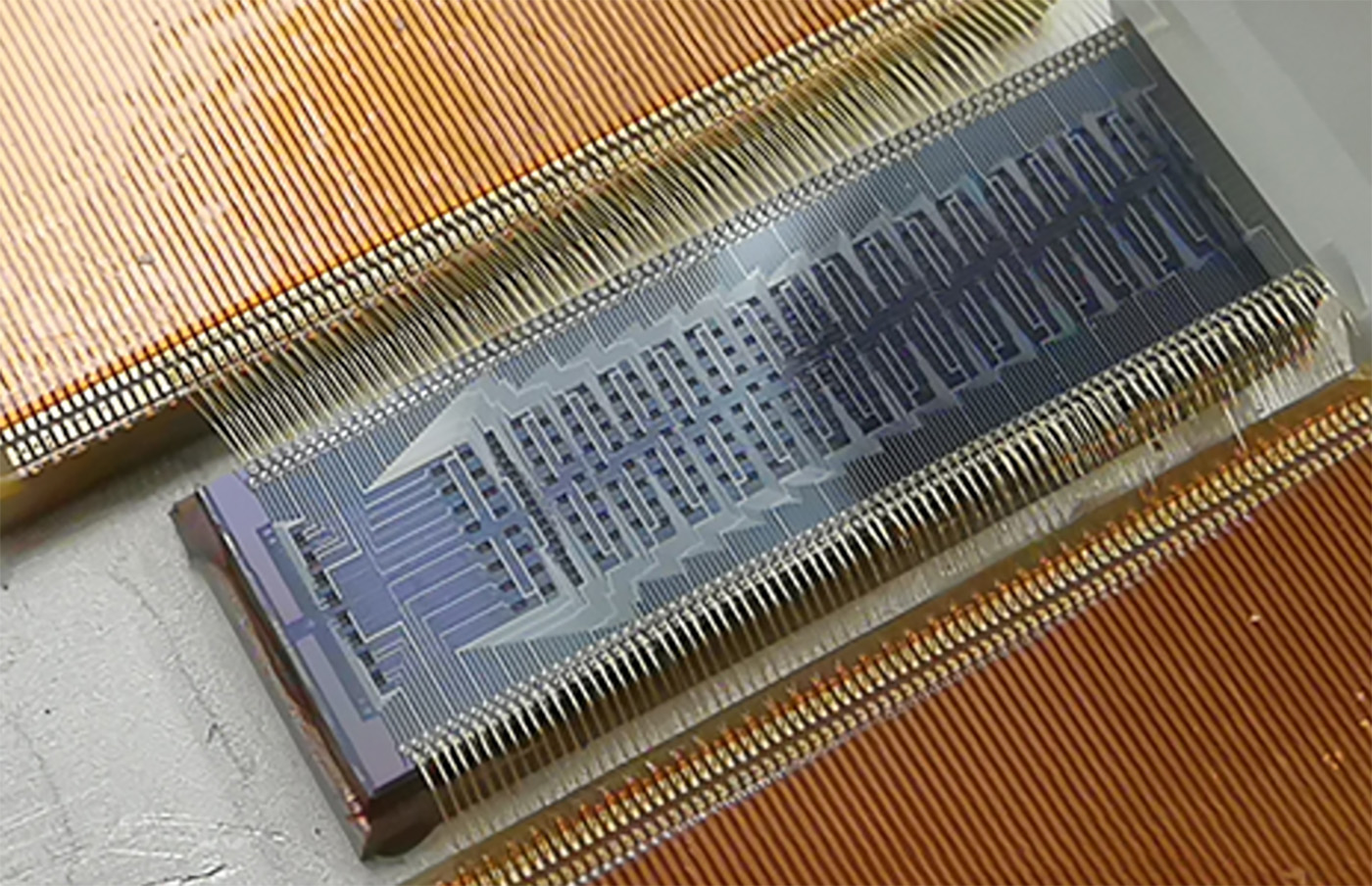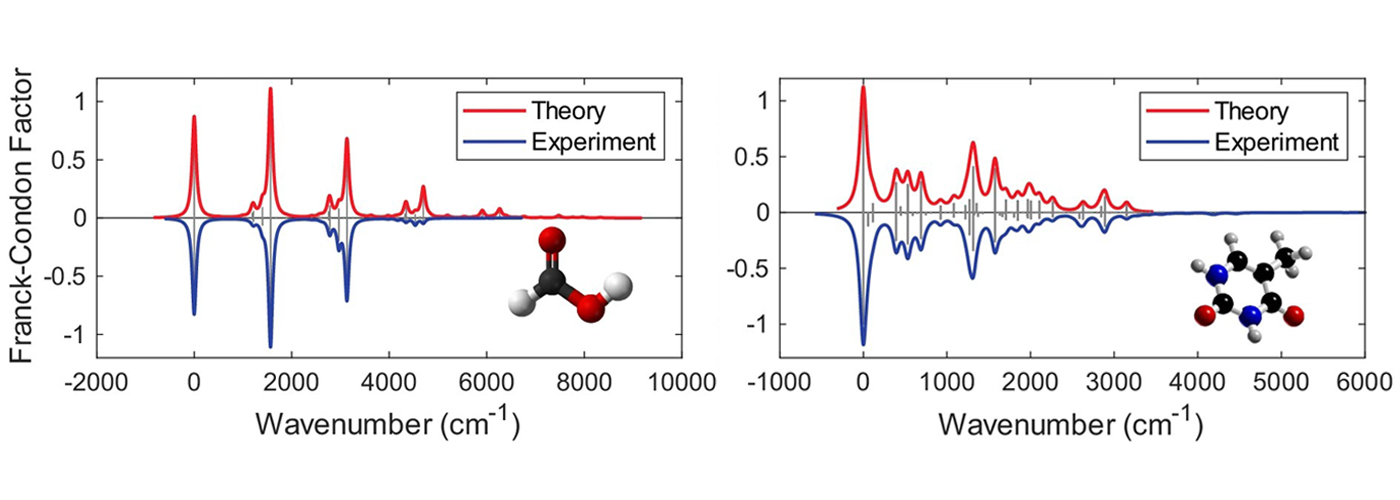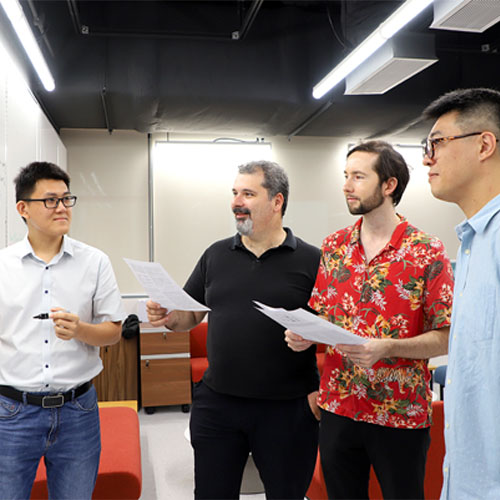Highlights
Molecules simulated on photonic chip for quantum chemistry
 For these experiments, the researchers used a chip measuring 13 by 4 millimetres with 16 photonic modes, 272 thermo-optic phase shifters, 319 multimode interferometer beam splitters and 65 optical couplers.
For these experiments, the researchers used a chip measuring 13 by 4 millimetres with 16 photonic modes, 272 thermo-optic phase shifters, 319 multimode interferometer beam splitters and 65 optical couplers.
Using light, a quantum microprocessor chip might simulate complex molecules for applications such as drug discovery. An international team including CQT’s Kwek Leong Chuan takes a step towards that goal with research published in Nature Communications on 18 July 2024.
All molecules vibrate, their structures flexing and rotating. Each of these so-called vibronic modes is associated with some energy levels. To understand the molecule’s chemical properties, it helps to know the probability that a molecule will transit from one energy level to another.
Kwek and his coauthors in Singapore, China, and Sweden have shown that they can calculate such transition probabilities using an integrated photonic chip. As a proof-of-concept, they simulated the vibronic spectra of formic acid (CH2O2) for four vibronic modes and thymine (C5H6N2O2) for seven modes using a 16-mode integrated photonic chip.
They also simulated spectra for naphthalene (C10H8), phenanthrene (C14H10), and benzene (C6H6) with a method that accounts for more diverse vibronic transitions.
While these spectra could easily be calculated by other means, such quantum simulations are expected to provide crucial insights into molecules with many atoms.
Calculating vibronic spectra becomes more difficult with bigger and more complex molecules, because bigger molecules can vibrate in many more ways. Consider a biological molecule that contains thousands or millions of atoms. On classical computers, the calculation needs a run time that scales exponentially with the number of energy levels.
Other teams have tried using trapped ions and superconducting circuits for quantum simulation of spectra. These platforms have so far only achieved simulation of molecules with two vibronic modes.
Kwek says, “What we have simulated in the experiment so far is just a few of the comparatively larger molecules. The experiment may pave the way towards even larger molecules with higher number of modes and photons.” Kwek is a CQT Principal Investigator, Co-Director of the Quantum Science and Engineering Centre at Nanyang Technological University, Singapore (NTU) and Professor at the National Institute of Education, NTU.
Integrated photonic chips also have the advantages of being compact, cost-effective and capable of operating at room temperature.
Boson sampling
The researchers use a technique known as scattershot boson sampling to simulate the molecules’ vibronic spectra, which is expected to make simulation more tractable.
Boson sampling is akin to the Galton board invented by Francis Galton during the Victorian period. The Galton board is a vertical board with rows of pegs. Beads dropped from the top bounce left and right as they hit the pegs on the way down, accumulating at the bottom of the board in a bell-shaped distribution.
Similarly, boson sampling has photons travelling through a circuit from some input ports to outputs. As the photons travel, they interfere with each other in a way that can be programmed. The researchers programme the circuit to simulate the vibronic modes of a molecule, obtaining the spectra by measuring the output distribution of the photons.
“What we simulated is not difficult for classical computers,” says Kwek. “But boson sampling has been shown to be difficult for classical computers as the number of particles and modes — pathways into a chip — increases. If we can go to a larger boson sampling chip, in principle, photonics could exceed the computational power of a classical machine.”
Experiment mirroring theory
For these experiments, the researchers used a chip measuring 13 by 4 millimetres with 16 photonic modes, 272 thermo-optic phase shifters, 319 multimode interferometer beam splitters and 65 optical couplers.
The team found their measurements agreed well with theory, achieving fidelities over 90% for all the molecules.
 Distributions obtained from the quantum experiments almost exactly track theory’s predictions. Researchers can calculate the vibronic transition probabilities of a molecule from what is known as the Franck Condon Factor. Franck??’Condon profiles obtained from chips programmed for formic acid (left) and thymine (right) had fidelities of 92.9% and 97.4% respectively. Image credit: Nat. Commun. 15, 6057 (2024).
Distributions obtained from the quantum experiments almost exactly track theory’s predictions. Researchers can calculate the vibronic transition probabilities of a molecule from what is known as the Franck Condon Factor. Franck??’Condon profiles obtained from chips programmed for formic acid (left) and thymine (right) had fidelities of 92.9% and 97.4% respectively. Image credit: Nat. Commun. 15, 6057 (2024).
As next steps, the researchers are looking to simulate bigger molecules and study the transitions between the excited states of a molecule.
They also want to look at effects of chemical changes, “such as a comparison of a molecule with and without an additional atom. We can then use the difference in the spectra to deduce the new chemical properties,” says Kwek. “I think there are a lot of new insights and possibilities for chemistry.”
Learn more
Related Stories
Novel solid-state device offers single photons on demand June 25 2024 | |
Less noise, please: a review of geometric quantum computing September 18 2023 | |
 | Algorithm calculates bond energies for quantum chemistry March 01 2024 |






